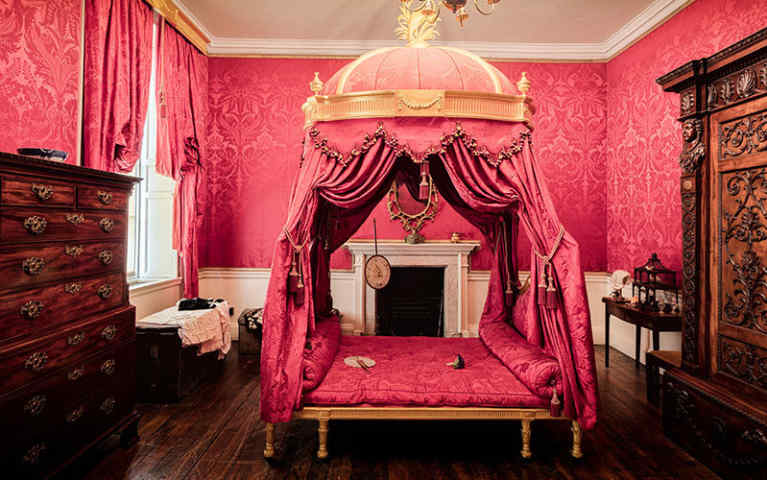How royal bedrooms have evolved throughout history. In the past, royal bedrooms were rarely used for sleep or intimacy alone. Rather, they were used for political gain and often, to "prove" the legitimacy of the upcoming royal line. Read more for history of the royal bedchamber according to several historians and authors who have long presented detailed, scholarly work on the ins and outs of royal life.
With a Royal wedding soon to come, there is a renewed interest in the private rooms and private lives of royals. Anna Whitelock, Director of the London Centre for Public History and Heritage, and author of "The Queen's Bed: An Intimate History of Elizabeth's Court," says it's only natural to be this curious.
"Everyone loves a wedding, but this one is significant [due to] marriage of an American into the family and also great affection for [the Prince,] says Whitelock. "[It's] a feel-good news story at a time of often bad news."
Royal bedchambers historically have been lush, decadent rooms with couches, tables, chandeliers and room for servants, writes Whitelock. The beds also traveled with the royals. No hotels needed!
"While the current Royal Family is a big tourism driver, many visitors are intrigued by kings and queens throughout English and British history, and to what lengths they would go to retain power – from the cut-throat Tudors, to the famously lavish Georgians," says Sally Coffey, freelance journalist and former editor of BRITAIN magazine. "Seeing inside their bedchamber is the ultimate glimpse into their private lives. Where did they sleep? Where did they bathe? It's a chance to humanize these legendary figures."
Read on for interesting bits of royal bedchamber history.
Childbirth Was Public
Up to 40 people would normally be present in the royal bedchamber to watch the birth of any royal child, according to the research of Lucy Worsley, who is a curator, historian and Chief Curator of Historic Palaces in England. She is also the presenter of a 2013 BBC documentary entitled "Tales From the Royal Bedchamber." Observing the birth is how the nation preserved the bloodline and ensured babies didn't get swapped out. This practice of public royal birthing occurred up to the early 1900s, which was when the parents of present monarchs decided that the world didn't need to see a royal baby physically being pushed out. Still, Whitelock agrees, the tradition – in a way – still holds today as some royal couples get dressed and show off the new prince or princess within hours of birth.
If you move over to review the history of The Queen's Apartments in the Chateau de Versailles in France, the birthing story is slightly different. The queen would give birth in her bedchamber, but she would labor upon a special bed brought in for that purpose as opposed to her royal bed. She was also allowed to labor behind a screen while only a handful of people were present. Meanwhile, other ladies in waiting and dignitaries overall waited in the Queen's Apartments. Elegant, flowered wallpaper and matching bedclothes covered this room, which also had partitions that dropped down from the ceiling.
Princess Bedrooms Were Like Modern-Day Great Rooms
Several exhibits over the years have recreated the bedrooms of princesses. One such exhibit, at Kew Palace, showcases the room of Princess Elizabeth, who is the daughter of George III. Reference materials show that her room had an elegant Grecian couch in it for sleeping and sitting outside of the actual bed. Princess Victoria's bedroom, currently preserved at Syon Park in England, is outfitted in gorgeous fabrics. The bed itself has a canopy and across from that is a table that could be used for breakfast. Syon Park was the Duke of Northumberland's London residence.
Politics Were Paramount
Kings and queens often held court in their bedchambers after they were awake and dressed by their servants. British historians liked this to a modern-day boardroom. According to one account, the bed itself was extraordinarily appointed with silks and drapes, and could be quite tall in order to emphasize the power of the monarch. That's according to Anna Whitelock, whose book details the work of the "ladies of the bedchamber."
"Monarchs would spend a lot of time here, and certainly from Henry VIII on, they were staffed by trusted intimates/friends, not just bodyservants," reports Whitelock. "So, all kinds of informal counsel."
Adds Coffey: "Here from the comfort of a grand bed, the monarch would conduct official business, including debating crucial political policies – even waging wars."
Luckily for today's royals and royal children, the bedchamber is a private affair; at least it appears that way from the outside. Servants no longer sleep within reach of the king, queen or prince. And, as civilization has modernized, that innermost royal sanctuary remains private and safe.
The Bigger the Better
IF there is anything a person can take away from historical royal bedrooms, it might be that bigger and plusher really is better.
"The more luxurious the bed the better," remarks Coffey. "Don't scrimp on fabric (some royal beds were 18 feet high and draped in silk hangings), but perhaps some things are best left behind closed doors (namely childbirth)."
If you’re looking to sleep better than royalty, consider getting a new mattress. Sleep Number® smart bed owners get almost 100 hours more proven quality sleep per year*
Like diet and exercise, quality sleep is essential for optimal wellbeing and performance. Because everyone's sleep needs are different, Sleep Number® smart beds sense your movements and automatically adjust firmness, comfort and support to keep you both sleeping comfortably. Find your Sleep Number® setting for your best possible night's sleep.
*Based on internal analysis of sleep sessions assessing sleepers who use multiple features of Sleep Number products. Claim based on sleepers achieving over 15 more minutes of restful sleep per sleep sessions.
